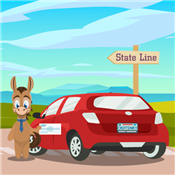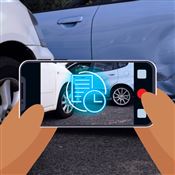Car Make and Model
Cars are often identified by their make and model. Find out what those terms mean and why your car's make and model matters.
 |
What Is the Make of a Car?
The make of a car is the brand that manufactures it. This includes companies like Ford, Honda, and Chevrolet.
Many manufacturers around the world build cars. In the U.S., you can buy vehicles made by domestic, Japanese, Korean, and European car manufacturers.
Some auto manufacturers produce two brands of vehicles: standard and luxury. For example, Acura is made by Honda. Acura is the luxury brand, and Honda is the standard brand. Despite being manufactured by Honda, they are sold at separate car dealerships.
- Purchase car insurance or change auto insurers
- Service your vehicle
- Need roadside assistance
- Call the police to report your car stolen
- Park it in a hotel lot when checking in
- Want to sell your car
Learn about all the places you can find your make and model down below.
What Is the Model of a Car?
The model of a car is the specific product name. For example, a Corvette is a model made by Chevrolet. For a Honda Accord, Honda is the make and Accord is the model.
The model doesn't have to be a word. In the case of the Audi Q3, it can be a combination of letters and numbers.
Identifying your car gets even more specific. Car models can come with different equipment and features. This is called the trim level. Learn more about the differences below.
What to Know About Trim and Body Style
With any car, the base model is the trim level with the least equipment and features. A fully loaded model offers the most equipment and features. There are also trim levels in between.
Trim is usually designated by letters or numbers after the model name. Some common ones are: DX, LS, or a series, like 300 or 500.
Trim levels can affect:
- Transmission: automatic, automated manual, or all-wheel drive
- Type of engine: powertrain and suspension
- Safety options: blind-spot monitoring, backup camera
- Interior features: material on the seats, navigation and entertainment systems, etc.
There can also be model versions with different body styles. Body style refers to the shape of a car: coupe, sedan, SUV, etc. For example, the Mazda 3 is available as a hatchback or a sedan.
Car trim levels significantly impact the Manufacturer Suggested Retail Price (MSRP). A base model vehicle can cost thousands less than one with a lot of features.
Here are some examples using the 2018 Honda Civic:
- Honda Civic LX (basic 4-door sedan): $20,635
- Honda Civic EX-L (well-equipped 4-door sedan): $24,895
- Honda Civic Touring (loaded 4-door sedan): $27,695
How to Find My Car's Make and Model
A vehicle's make and model is listed in several places. Here's how you can find yours:
Outside of Your Vehicle
The back of your car should have the manufacturer's name on one side and the model on the other side. Plus, the car maker's logo is usually on the front and back of your car.
Owner's Manual
The make and model of the vehicle is usually located on the cover of the owner's manual. Or, it can be found within its first few pages.
Title or Registration
Your car make and model is prominently displayed on both documents.
Use the Car's Vehicle Identification Number (VIN)
You can enter your VIN into the National Highway Traffic Safety Administration's VIN Decoder web page. It'll reveal your car's make, model, and other details.
The VIN is a 17-digit code made up of letters and numbers. It can be found:
- On the driver's side of the dashboard where it meets the windshield
- On the driver's side door jamb
- Printed on your vehicle's registration
The 17-character VIN identifies a lot about your car, including the model year. Here's what each character (a number or letter) represents, from left to right:
- 1st character: Country of manufacture
- 2nd character: Manufacturer
- 3rd character: Vehicle type
- 4th–8th characters: Brand, body style, model, and series
- 9th character: Security check number
- 10th character: Model year
- 11th character: Assembly plant
- 12th–17th characters: Vehicle's serial number
Car History Report
If your car was preowned, you can get its make and model by requesting a vehicle history report from your local Department of Motor Vehicles (DMV). You will need the car's title, VIN, and proof of identification.
The car history report contains:
- Record of past ownership
- Vehicle's title
- Odometer settings
- Existing liens on the vehicle
- Past maintenance
Your car make and model tells insurance companies a lot about your future driving behavior. See how it could affect your rates below.
Find Cheap Car InsuranceSelect your state to get started
How Make and Model Affect Car Insurance
Do you have expensive car insurance? It might have to do with your car. Auto insurance companies consider your car when setting your premium.
Be sure to provide the entire model when you request an insurance quote. This includes all letters, numbers, and trim level indicators. You don't want rates for a higher-priced model when you have a lower one.
Here are some ways your car make and model affect your rates:
Factors That Raise Insurance
- The car has a high value with higher costs for comprehensive and collision coverage.
- Many claims are filed for that specific car.
- The vehicle does not have advanced safety features.
Factors That Lower Insurance
- The vehicle has a high safety rating from the National Highway Traffic Safety Administration.
- Advanced safety features are equipped on the vehicle.
- The make and model is equipped with anti-theft features.
- Performance or sports cars
- Convertibles
- High-end luxury cars
- Exotic vehicles
- Vintage or antique cars
For example, the MSRP for the Toyota Camry Hybrid LE is higher than the LE. But the Hybrid LE owner pays less for car insurance because the Hybrid LE has more safety features.
Here's how annual insurance rates for a 2019 Toyota Camry stack up:
| Model/Trim Level | MSRP | Annual Insurance Rate |
|---|---|---|
| Camry L | $24,095 | $1,944 |
| Camry LE | $24,600 | $2,405 |
| Camry Hybrid LE | $28,400 | $2,355 |
| Camry SE | $25,800 | $2,395 |
| Camry Hybrid SE | $30,100 | $2,365 |
| Camry XLE | $29,175 | $2,403 |
| Camry Hybrid XLE | $32,975 | $2,380 |
| Camry XLE V6 | $34,300 | $2,403 |
| Camry XSE | $29,725 | $2,405 |
| Camry XSE V6 | $34,850 | $2,406 |
How to Buy Insurance for Your Make and Model
 |
To buy insurance, start by getting a quote for your make and model. You can do this online, through an agent, or by calling an insurance company directly.
Find out below what it takes to get insured from start to finish.
Avoid This Car Insurance Red Flag
If you get a loyalty discount with your insurance company, you're probably overpaying. Insurance companies raise their prices every year. The only way to get cheap insurance is to compare quotes from different companies.
Requesting an Auto Insurance Quote
When applying for an auto insurance quote, you'll need to provide the following information:
- Make, model, and year of your car, including trim level and body style
- VIN
- Your age and gender
- Driver's license number of anyone who will be on the policy
- Vehicle registration
- Driving history
- Credit history
Customizing Your Quote with Coverages
Most U.S. states require certain coverage minimums. But you can purchase higher amounts. Your insurance amount should be enough to cover the cost of a serious accident.
Read on to learn the coverages you should consider for your auto insurance policy.
Mandatory Coverage (in most states)
- Bodily injury liability pays for the costs of injuries and death caused by you or someone driving your car.
- Property damage liability pays for damages you cause to someone else's car or property, like a utility pole, fence, or building.
- Medical payments and personal injury protection (PIP) pays your and your passengers' medical expenses in a car accident. The coverage also reimburses for lost wages and other expenses.
- Uninsured/underinsured motorist covers you if you are in an accident caused by an uninsured or underinsured motorist. It also applies to hit-and-run situations.
Optional Coverage
- Collision insurance covers damage to your car from a collision you caused. It applies whether you collide with another car or an object like a guard rail.
- Comprehensive covers theft and damage caused by something other than an accident. Some examples are:
- Tree falling on your car
- Flood
- Fire
- Falling rocks
- Hail
- Vandalism
If you lease or finance your car, most lenders require you to purchase comprehensive coverage.
- Tree falling on your car
- Glass coverage deals with damage to your windshield, side and rear windows, and sunroof.
- Gap coverage pays off what you owe your lender/leasing company if your car is stolen or totaled. Usually, this coverage is included in the lease amount of a car.
Applying for an Auto Insurance Policy
Once you receive quotes from at least 3 auto insurers, you can compare:
- Coverage deductibles, limitations, and exclusions
- Coverage amount
- Discounts
- Financial stability rating from Moody's or AM Best
- Customer service and claims ratings from J.D. Power
- Price in relation to above factors
Next, select the best auto insurance company for your needs and complete your application. The auto insurer will review your application and give you the final price for your car insurance policy.
Bottom Line
Cars are identified by make and model. The make identifies which auto manufacturer built it, while the model identifies the product line.
Some car models have several versions, each with added features or trim levels. A model of the same make might be a coupe vs. a sedan, or a 6-cylinder vs. a 4-cylinder car.
It's important to know the make and model of your car. It'll come in handy for many purposes throughout your car's life. You'll need the information to register it, insure it, identify it, or sell it.
Write to Maryellen Cicione at feedback@creditdonkey.com. Follow us on Twitter and Facebook for our latest posts.
Note: This website is made possible through financial relationships with some of the products and services mentioned on this site. We may receive compensation if you shop through links in our content. You do not have to use our links, but you help support CreditDonkey if you do.
Read Next:






